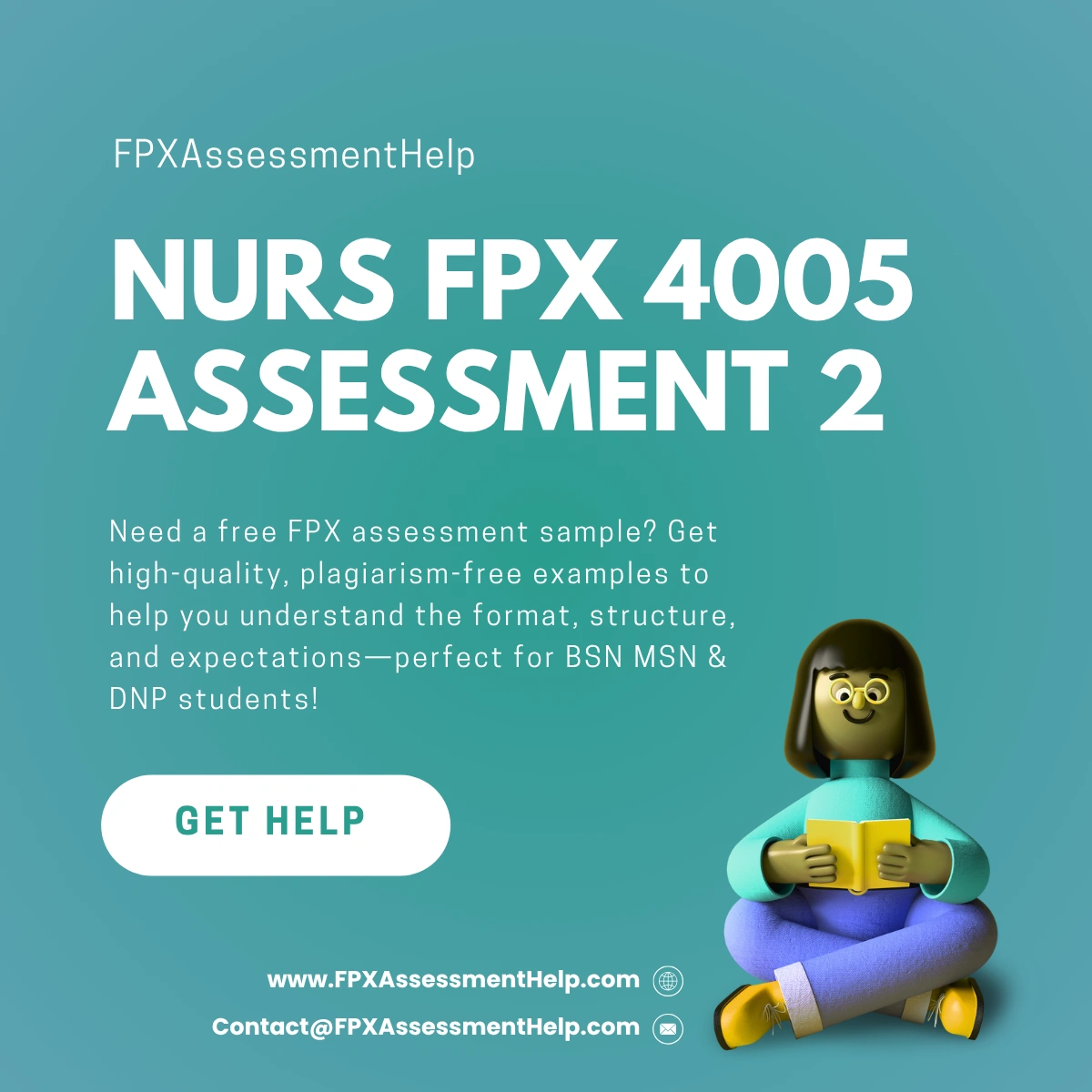NURS FPX 4005 Assessment 2 Interview and Interdisciplinary Issue Identification
Student Name
Capella University
NURS-FPX4005 Nursing Leadership: Focusing on People, Processes, and Organizations
Prof. Name
Date
Interview Summary
During my placement at Willow Creek Geriatric and Rehabilitation Center (WCGR), I conducted an interview with Marcus, the senior charge nurse, to understand leadership challenges within the facility. WCGR is a long-term care institution that offers rehabilitation services and palliative care for elderly patients. Marcus plays a pivotal leadership role by assigning daily tasks, organizing weekly multidisciplinary team meetings, mentoring new nurses, and resolving operational concerns. The interview, conducted through open-ended questions, provided valuable insights into staff management and broader organizational issues (Smith et al., 2022).
One significant concern Marcus highlighted was the ongoing burnout experienced particularly by night-shift nurses. Despite existing efforts such as shift rotations and mental health workshops, burnout persists, adversely affecting staff retention and patient care quality. Marcus emphasized the importance of engaging frontline workers in decision-making and tailoring wellness programs based on staff feedback. Although leadership is aware of the issue, implementation of new strategies has been delayed, signaling a need for more inclusive and responsive approaches.
Identification of Issue
Marcus identified nurse burnout—especially among those working night shifts—as a major challenge at WCGR. The high-pressure environment, emotional fatigue, and lack of rest have led to decreased job satisfaction, poor interdepartmental collaboration, and a noticeable decline in patient care standards. This has contributed to increased turnover rates and reduced employee morale (Simms et al., 2023).
To mitigate this issue, WCGR can implement structured interprofessional collaboration and distribute responsibilities more evenly among departments. Incorporating resilience-building initiatives such as wellness activities and emotional intelligence training may enhance workplace communication and reduce stress (Flaherty & Bartels, 2019). Furthermore, cross-training staff can ensure greater operational flexibility during peak periods (Clifford, 2021). Organizational strategies must also prioritize recognition programs, flexible scheduling, and support networks to boost retention (Malaki, 2022). Through an integrated and collaborative framework, WCGR has the opportunity to build a more sustainable and supportive working environment.
Table 1: Strategies for Addressing Nurse Burnout
| Strategy | Description |
|---|---|
| Cross-Training | Allows nurses to take on various roles, enhancing adaptability. |
| Wellness Programs | Includes mindfulness, resilience training, and emotional support resources. |
| Flexible Scheduling | Offers shifts that support work-life balance. |
| Recognition and Support | Encourages morale by acknowledging employee contributions. |
| Team-Based Collaboration | Enhances support through interdepartmental cooperation. |
Change Theories and Leadership Strategies
Implementing effective change at WCGR requires both structured change models and adaptive leadership strategies. The ADKAR model (Awareness, Desire, Knowledge, Ability, Reinforcement) provides a sequential approach to help staff transition smoothly. This model builds awareness of burnout, fosters a shared desire for change, enhances competencies, and promotes continuous support to ensure long-term improvement (Ziataki, 2023; Chen et al., 2022).
Similarly, Lewin’s Change Management Model—comprising Unfreezing, Changing, and Refreezing—guides organizations through transformation. Initially, WCGR must recognize the burnout crisis (Unfreezing), introduce interdisciplinary interventions such as task redistribution and wellness sessions (Changing), and stabilize these solutions within daily routines (Refreezing) (Ash & Miller, 2021).
Table 2: Application of Change Models in WCGR
| Change Model | Phases | WCGR Implementation Example |
|---|---|---|
| ADKAR | Awareness → Desire → Knowledge → Ability → Reinforcement | Conducting burnout surveys, training sessions, and feedback loops |
| Lewin’s Model | Unfreezing → Changing → Refreezing | Acknowledging burnout → Launching wellness plans → Institutionalizing improvements |
To supplement these models, collaborative leadership encourages inclusive participation across all levels, ensuring that healthcare professionals jointly contribute to burnout mitigation strategies (Grimani & Gotsis, 2023). Meanwhile, transformational leadership inspires staff by cultivating a shared vision, promoting autonomy, and fostering innovation. Such leadership not only motivates employees but also enhances their commitment to the organization’s mission (Rizkia et al., 2022). Both leadership styles support interprofessional harmony and align well with WCGR’s goals for a healthier work culture.
Collaborative Approaches for Interprofessional Teams
Fostering collaboration across professional boundaries is essential for tackling burnout at WCGR. Regular interdisciplinary meetings can serve as a platform for dialogue on emotional health and burnout prevention. These sessions should include a diverse group of professionals, such as nurses, physicians, IT specialists, pharmacists, and administrative staff, to ensure a comprehensive view of workplace dynamics (Fox et al., 2021).
A designated intervention leader should coordinate efforts, assign clear responsibilities, and create structured care plans. This reduces confusion, streamlines workflow, and facilitates quick adaptation during high-demand periods. Additionally, the integration of Electronic Health Records (EHRs) can significantly enhance communication among departments, decrease administrative burden, and improve collaborative decision-making (Robertson et al., 2022).
Table 3: Collaborative Tools and Roles
| Element | Function |
|---|---|
| Interdisciplinary Meetings | Enable cross-departmental dialogue on wellness and stressors |
| Defined Roles | Clarify responsibilities during daily operations and crisis events |
| EHR Systems | Improve information flow and decrease redundant documentation |
| Wellness Coordinators | Oversee implementation of staff-centered well-being programs |
By prioritizing structured collaboration, WCGR can create a more resilient, responsive, and inclusive environment where staff feel supported and engaged in both patient care and organizational development.
Conclusion
In conclusion, addressing burnout among staff at WCGR involves the integration of systemic change models, strong leadership, and team-oriented collaboration. Implementing frameworks such as ADKAR and Lewin’s model ensures that change is strategic and sustainable. Leadership styles that emphasize shared vision and inclusivity further strengthen staff engagement. Ultimately, WCGR must invest in regular interprofessional communication, use technology to reduce inefficiencies, and tailor wellness initiatives to staff needs. Through these coordinated efforts, the organization can create a supportive and productive work environment.
References
Antonsdottir, I., Rushton, C. H., Nelson, K. E., Heinze, K. E., Swoboda, S. M., & Hanson, G. C. (2021). Burnout and moral resilience in interdisciplinary healthcare professionals. Journal of Clinical Nursing, 31(1–2), 196–208. https://doi.org/10.1111/jocn.15896
Ash, L., & Miller, C. (2021). Interprofessional collaboration for improving patient and population health. In The Doctor of Nursing Practice Essentials. Jones and Bartlett Learning.
Chen, J., Ghardallou, W., Comite, U., Ahmad, N., Ryu, H. B., Ariza-Montes, A., & Han, H. (2022). Managing hospital employees’ burnout through transformational leadership: The role of resilience, role clarity, and intrinsic motivation. International Journal of Environmental Research and Public Health, 19(17), 10941. https://www.ncbi.nlm.nih.gov/pmc/articles/PMC9518422/
NURS FPX 4005 Assessment 2 Interview and Interdisciplinary Issue Identification
Clifford, T. (2021). Cross-training. Journal of PeriAnesthesia Nursing, 36(6), 736–737. https://doi.org/10.1016/j.jopan.2021.09.003
Fox, K. E., Johnson, S. T., Berkman, L. F., Sianoja, M., Soh, Y., Kubzansky, L. D., & Kelly, E. L. (2021). Organisational- and group-level workplace interventions and their effect on multiple domains of worker well-being: A systematic review. Work & Stress, 36(1), 1–30. https://doi.org/10.1080/02678373.2021.1969476
Grimani, A., & Gotsis, G. (2023). Embracing inclusive leadership for collaborative healthcare work environments: Fostering wellness in ambivalent situations. Springer EBooks, 209–229. https://doi.org/10.1007/978-3-031-35494-6_11
Malaki, S. (2022). Optimal recruitment of temporary and permanent healthcare workers in highly uncertain environments [Doctoral Thesis, University of London]. https://openaccess.city.ac.uk/id/eprint/30097/
McCormick, E., Devine, S., Crilly, J., Brough, P., & Greenslade, J. (2022). Measuring occupational stress in emergency departments. Emergency Medicine Australasia, 35(2), 234–241. https://doi.org/10.1111/1742-6723.14101
NURS FPX 4005 Assessment 2 Interview and Interdisciplinary Issue Identification
Rizkia, D. G., Girsang, A. J., Kusumapradja, R., Hilmy, M. R., Pamungkas, R. A., & Dewi, S. (2022). The effect of interprofessional collaboration and transformational leadership on patient safety with work motivation as intervening variables. Riset, 4(2), 039–053. https://doi.org/10.37641/riset.v4i2.156
Robertson, S. T., Rosbergen, I. C. M., Jones, A. B., Grimley, R. S., & Brauer, S. G. (2022). The effect of the electronic health record on interprofessional practice: A systematic review. Applied Clinical Informatics, 13(03), 541–559. https://doi.org/10.1055/s-0042-1748855
Simms, L., Ottman, K. E., Griffith, J. L., Knight, M. G., Norris, L., Karakcheyeva, V., & Kohrt, B. A. (2023). Psychosocial peer support to address mental health and burnout of health care workers affected by COVID-19: A qualitative evaluation. International Journal of Environmental Research and Public Health, 20(5), 4536. https://doi.org/10.3390/ijerph20054536
Smith, K., Maynard, N., Berry, A., Stephenson, T., Spiteri, T., Corrigan, D., Mansfield, J., Ellerton, P., & Smith, T. (2022). Principles of problem-based learning (PBL) in STEM education: Using expert wisdom and research to frame educational practice. Education Sciences, 12(10), 728. https://doi.org/10.3390/educsci12100728
Ziataki, E. (2023). Navigating change: Lessons learned from implementing a change management plan to improve team performance. https://www.theseus.fi/handle/10024/807294





